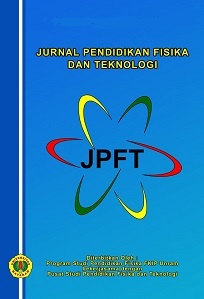Pengembangan Bahan Ajar Kompilasi Fisika Matematika II Pokok Bahasan Persamaaan Diferensial Untuk Meningkatkan Penalaran Matematis
DOI:
10.29303/jpft.v3i2.414Published:
2017-12-21Issue:
Vol. 3 No. 2 (2017): Juli - DesemberKeywords:
compilation, differential equations, mathematical reasoningArticles
Downloads
How to Cite
Downloads
Metrics
Abstract
This study aims to develop and produce teaching materials compilation of mathematical physics II on the subject of differential equations. Teaching materials that have been developed in the form of teaching modules. The research method used is a development study consisting of four stages: the stage of determination, design, development, and disseminate. The results obtained from this research are in the form of teaching module of mathematical physics II differential equation and its application. The teaching module generated in terms of feasibility aspects of content, presentation, and linguistics obtained amean score is 92.5 with a percentage is 79.74%. This shows that the teaching module that has been created as good and feasible to use. It can be categorized effective as measured by the impact of student activities, responses, and value of students reasoning abilities. The impact of student activity seen during the learning process after using the module is 73.59% and the student activity is categorized much or quite practical. The percentage of students' response after using the module was 80.1% and categorized well. The impact on the mathematical reasoning ability meanscore of the class 70.87.ÃÂ This shows that the teaching module that has been created can beÃÂ categorizedeffetive. Thus, it can be concluded that the teaching module compilation of mathematical physics II the subject of differential equations and their applications can be said to be effective and feasible to use.References
Arjudin. 2005. Persamaan Diferensial. Program Studi Pendidikan Matematika Jurusan PMIPA FKIP Universitas Mataram.
Amilia, T. N., Andriani, N., Zulherman. 2016. Pengembangan Bahan Ajar Cetak Mata Kuliah Fisika Matematika Pokok Bahasan Bilangan Kompleks di Program Studi Pendidikan Fisika Universitas Sriwijaya. Jurnal Inovasi dan Pembelajaran.Fisika.Dari://ejournal.unsri.ac.id/index.php/jipf/article/view/3851.
Ellianawati, & Wahyuni, S. 2012. Pengembangan Bahan Ajar Fisika Matematika Berbasis Self Regulated Learning Sebagai Upaya Peningkatan Kemampuan Belajar Mandiri. Jurnal Pendidikan Fisika Indonesia, 10(2),33-40.
Farman. 2017. Pengembangan Perangkat Pembelajaran Dengan Pendekatan Problem Posing Untuk Meningkatkan Kemampuan Penalaran Pada Materi Lingkaran Siswa Kelas VII . Prosiding. Seminar Nasional IKA IKIP Mataram Epistimologi Perkembangan Kurikulum Pendidikan di Indonesia (494-513).
Fatmaryanti, D.,S. 2014. PeningkatanAktivitas dan Hasil Belajar Fisika Matematika I Dengan Metode Brainstorming dan Tutor Teman Sebaya, JRKPF, 1(1).
Gunada, I. W., Sahidu, H., Sutrio. 2015. Pengembangan Perangkat Pembelajaran Fisika Berbasis Masalah Untuk Meningkatkan Hasil Belajar dan Sikap Ilmiah Mahasiswa. Jurnal Pendidikan Fisika dan Teknologi. 1(1), 38-46.
Habibi, & Herayanti, L., 2016. Pengembangan Buku Ajar Fisika Dasar I Berbasis Self Regulated Learning Sebagai Upaya Memotivasi Mahasiswa Untuk Belajar Mandiri. Jurnal Pendidikan Fisika dan Teknologi. 2(4), 154-158.
Lestari, D. 2013. Diktat Persamaan Diferensial. Jurusan Pendidikan Matematika Fakultas MIPA. Universitas Negeri Yogyakarta
Murdiyanto, T. 2016. Pengembangan Bahan Perkuliahan Kompilasi Mata Kuliah Persamaan Diferensial Elementer Prodi Pendidikam Matematika. Prosiding. Konferensi Nasional Penelitian Matematika dan Pembelajarannya (KNMPPI) Universitas Muhammadyah Surakarta. 12 Maret 2016.
Nuraeni, Z. 2017. Aplikasi Persamaan Diferensial dalam Estimasi Jumlah Populasi. Jurnal Ilmiah Pendidikan Matematika, 5(1), 9-16.
Young, H. D., & Freedman, R. A., Sadin, T. R., Ford, A. L. 2003. Fisika Universitas. Terjemahan Pantur Silaban. Jakarta: Erlangga.
Septian, A. 2014. Pengaruh Kemampuan prasyarat Terhadap Kemampuan Penalaran Matematis Mahasiswa dalam Matakuliah Analisis Real. Jurnal Kajian Pendidikan. 4(2), 179-188.
Suharnan.2005. Psikologi Kognitif. Surabaya: Penerbit Srikandi.
Wahyudi. 2015. Analisi Hasil Belajar Mahasiswa Pada Pokok Bahasan Hukum Ohm dan Kirchoff dalam Matakuliah Elektronika Dasar I. Jurnal Pendidikan Fisika dan Teknologi. 1(2), 129-134.
License
Authors who publish with Jurnal Pendidikan Fisika dan Teknologi (JPFT) agree to the following terms:
- Authors retain copyright and grant the journal right of first publication with the work simultaneously licensed under a Creative Commons Attribution License 4.0 International License (CC-BY-SA License). This license allows authors to use all articles, data sets, graphics, and appendices in data mining applications, search engines, web sites, blogs, and other platforms by providing an appropriate reference. The journal allows the author(s) to hold the copyright without restrictions and will retain publishing rights without restrictions.
- Authors are able to enter into separate, additional contractual arrangements for the non-exclusive distribution of the journal's published version of the work (e.g., post it to an institutional repository or publish it in a book), with an acknowledgement of its initial publication in Jurnal Pendidikan Fisika dan Teknologi (JPFT).
- Authors are permitted and encouraged to post their work online (e.g., in institutional repositories or on their website) prior to and during the submission process, as it can lead to productive exchanges, as well as earlier and greater citation of published work (See The Effect of Open Access).











